Part 1 Definition of the Stopping Set Screw on a
Canon Lens
With all the concerns recently of possible damage to the
AF control
by the use of “non-Canon” lens adapters, I wanted to
post this quick article to address some of the concerns. Whenever
you use a non-Canon lens adapter, there is always a risk of damage
however it should in my opinion be no more risky than using a OEM
lens on your camera as both are using a lens adapter that wasn’t
made by Canon.
After following up on some of the posts regarding the damage, one
term kept coming out, “stopping set screw”. I wasn’t
sure exactly what this was and did some research on my own equipment.
I quickly learned the stopping set screw’s purpose and what the
cause of the damage may have been from.
All the Canon lenses I own have a stopping set screw. At first I wasn’t
really sure how this screw worked in conjunction to mounting or un-mounting
a Canon lens. In the picture below you will see the stopping set screw
on a Canon 24-70 lens. Look at the 2nd image where the red alignment
dot is at the top (12:00 o’clock) and you can see that the location
of the set screw is about the 10:00 o’clock position on the mount.
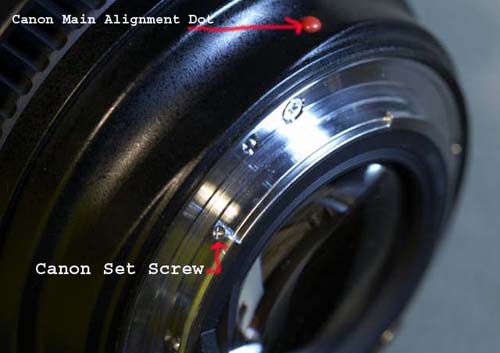
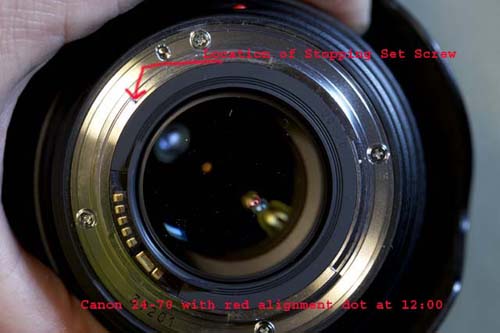
On closer examination of all my Canon lenses, (100mm macro, 70-200mm
IS, 28-105mm, 24mmTS-E and 45mm TS-E) I noticed all had the exact
same stopping set screw in the same spot. I then took my 24-70mm and
started
mounting and un-mounting it which is something I do hundreds of times
on a shoot. I realized immediately what the stopping set screw did.
The purpose of the screw is to stop you from twisting the lens too
far to the left (counter-clockwise) while removing it. It doesn’t
have anything to do with mounting the lens. As you remove the lens,
when the two red alignment dots line up you will feel a click. The
click is the stopping set screw engaging and stopping the counter
clockwise motion from going any further and causing damage.
If you
have a lens adapter without this stopping set screw, then it would
be possible to continue to twist the lens counter-clockwise and
do damage to the AF pin. In the picture show below, you can see the
EOS AF pin. This pin on an EOS mount is just past the 10:00 o’clock
position and appears to be made of a plastic/rubber material. I point
this out as it was quickly apparent to me that this pin would not
hold up well if metal was pushed against it, like the metal of a
lens mounting
ring.
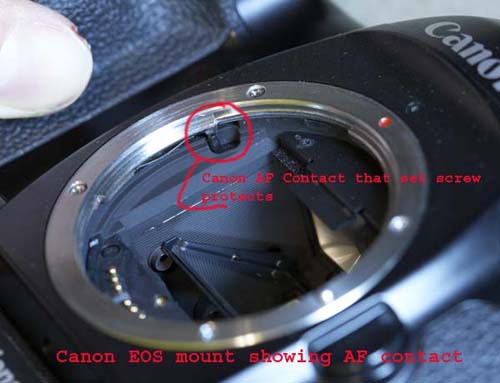
Part 2, Scrutiny of Lens Adapters for a stopping set screw
My next step was to go back and closely examine all the lens adapters
I currently had. These included:
1. Cameraquest, for both Nikkor and Contax
2. DSLReXchange for Contax
3. Zoerk/PSA adapter.
I noticed that of the three, only two were designed with some form
of a stopping set device, Zoerk and the Cameraquest. In the next series
of images, I have taken close ups of both the Zoerk and Cameraquest
showing how they have implemented a stop in their design. Here is the
Cameraquest adapter, note that Cameraquest uses a bend or crimp in
the mounting flange, at the same point where Canon would have put their
stopping set screw. The crimp is very pronounced and not something
that is going to be bent backwards.
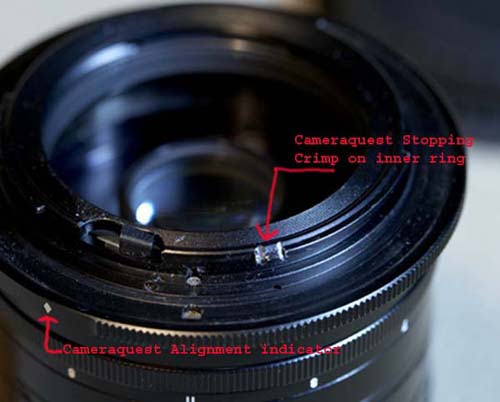
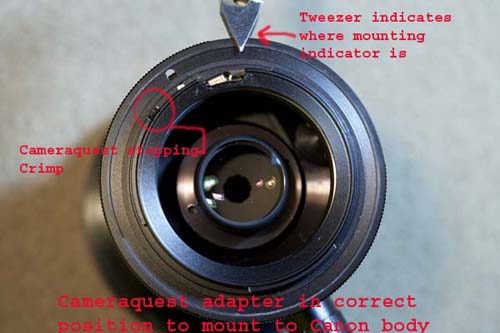
On the Zoerk adapter, there is an actual screw set in the basically
the same manner as how Canon mounts theirs. The Canon screw is more
substantial but the Zoerk design does hit the point and stop the rotation.
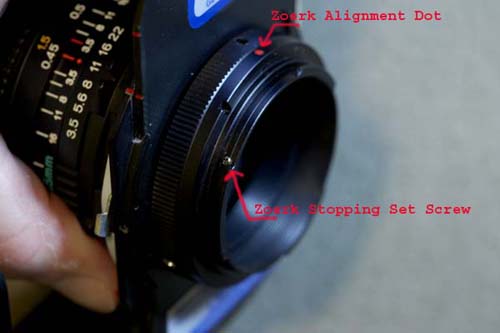
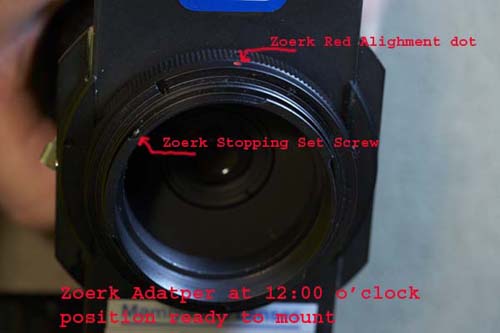
Unfortunately, my DSLReXchange adapter that I have doesn’t have
any form of a stopping set screw. I would have to say at this point
that until an improved design becomes available that I would not recommend
the use of this adapter as it would be possible to turn it past the
normal stopping point and do damage to the AF engagement pin.
I hope that this brief article will give people enough information
to make the correct decisions when considering the use of lens adapters.
In conclusion, make sure that there is some form of a stopping screw
or crimp at the 10:00 o’clock position on the adapter in question.
Please feel free to ask me any questions directly. I can be reached
at the following email address: pcaldwe@aristotle.net
www.photosofarkansas.com
|